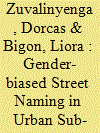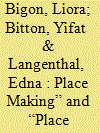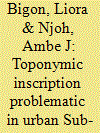|
|
|
Sort Order |
|
|
|
Items / Page
|
|
|
|
|
|
|
| Srl | Item |
| 1 |
ID:
179111


|
|
|
|
|
| Summary/Abstract |
This article explores the present-day problematic of gender-biased street names as prevalent in sub-Saharan Africa’s cityscapes. That is, the abundance of masculine street names as opposed to feminine ones in the urban environments of this region. The article first provides a comparative view on the scope of this toponymic phenomenon in other geographic regions with relation to sub-Saharan Africa. It also identifies few decisive factors in the creation of the gender-biased urban landscapes in sub-Saharan Africa. These factors consist of: recent tendencies in critical toponymy studies; colonial and post-colonial cultures of governmentality; and inadequate urban planning legislation and vision as pertained by post-colonial states. This toponymic problematic is then exemplified in a site-specific analysis of the city of Bindura in north-eastern Zimbabwe. The article concludes with recommendations for designing a more socially inclusive urban management policy in the region, pointing to future research directions of this under-studied phenomenon in critical place-name studies.
|
|
|
|
|
|
|
|
|
|
|
|
|
|
|
|
| 2 |
ID:
147331


|
|
|
|
|
| Summary/Abstract |
This historical essay critically examines the early military settlement projects realized by the French Engineering Corps in Senegal and the Western Sudan during the second half of the 19th century. The French were preoccupied with the establishment of official control over the hinterland, confronting a variety of challenges in situ. In striving to go beyond the prestigious image of the Corps and the discourse on colonial settlement forms as an instrument for domination, this article exposes aspects of uncertainty and haphazardness behind the projects. Visual correspondence with indigenous cultures is expanded, employing a rich variety of historical sources.
|
|
|
|
|
|
|
|
|
|
|
|
|
|
|
|
| 3 |
ID:
188945


|
|
|
|
|
| Summary/Abstract |
This article expands on the usability of the concepts of “place making” and “place attachment” as recently developed in urban studies research in the context of housing insecurity of marginalized communities in today’s neo-liberal city. Particularly, against the growing threat of urban evictions, the article utilizes a transdisciplinary approach, showing the relevance of both concepts for (a) a better understanding of bottom-up processes of spatial production and attempts to create a sense of place on the part of such communities, and (b) offering an innovative legal strategy for doing justice to these communities in terms of their compensation rights, especially where a title to land has not been registered on a private basis. These issues are critically examined on the site-related case of the Givat-Amal quarter in Tel Aviv, Israel. This district is now under actual final threat of forced evictions following seven conflicted decades with the state, municipal authorities and private entrepreneurs. Our transdisciplinary study is based on qualitative methodologies in human geography such as fieldwork, visual evidence, and interviews, with a glimpse into philosophy. It is equally based on revisiting “traditional” legal property rights through the lens of post-liberal human rights analysis. The argument can apply to many situations of forced evictions across Africa, Latin America, and the West itself.
|
|
|
|
|
|
|
|
|
|
|
|
|
|
|
|
| 4 |
ID:
161624


|
|
|
|
|
| Summary/Abstract |
This paper analyzes strategies for articulating power and effectuating social control in the built environment by French colonial authorities in New France and colonial Africa. The former was a settler colony while the latter comprised colonies of economic exploitation. Despite their different colonial status, they shared much in common. In this regard, French colonial authorities recycled spatial control strategies they had employed in New France a century earlier for use in Africa. However some changes commensurate with the changing priorities and objectives of the French colonial project were instituted. In particular, recycled policies from New France were made more stringent, less tolerant and ostensibly oppressive in French colonial Africa.
|
|
|
|
|
|
|
|
|
|
|
|
|
|
|
|
| 5 |
ID:
137004


|
|
|
|
|
| Summary/Abstract |
We examine a variety of problems relating to toponymic inscription processes in urban sub-Saharan Africa. The objective is to promote understanding of: the origins, evolution, nature, extent and social implications of these problems in an era of globalization; the vocabularies of built space; and the navigation techniques of inhabitants of supposedly nondescript built space in this region. We employed primary data based on in situ experiences and secondary data from published and unpublished documents. We found that the region’s toponymic inscription problem, its built space, and urban vocabularies are deeply embedded in its European colonial legacy. Furthermore, we found that urban residents in this region have devised functional means to navigate their seemingly nondescript space. These revelations promise to fill some historiographic gaps in the literature on toponymic inscription in Africa in particular and urban history and planning in general.
|
|
|
|
|
|
|
|
|
|
|
|
|
|
|
|
|
|
|
|
|